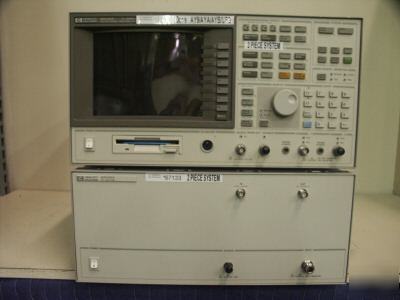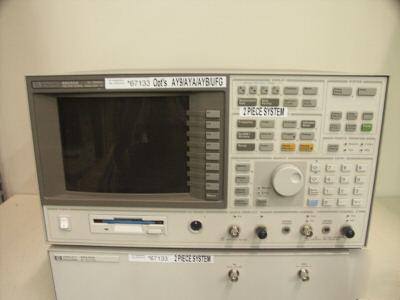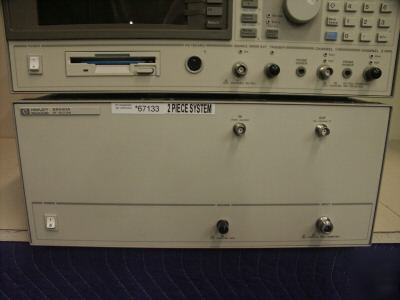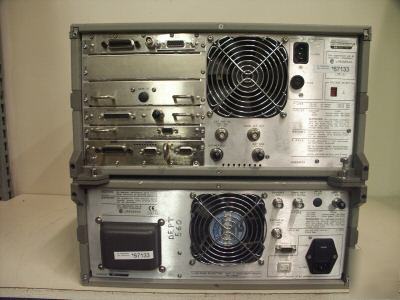Your Classified Ad Destination for Hutsville area > North Hutsville
> 2008
> Hp 89440A vector signal analyzer: dc to 1.8 ghz.2 piec
Hp 89440A vector signal analyzer: dc to 1.8 ghz.2 piec
HP/Agilent 89440A Vector Signal Analyzer: 2MHz. to 1.8 GHz. (Consists of the 89410A and the 89430A)
This Analyzers Offer Complex Signal Analysis, Such as Digital Modulation Analysis and AM/FM/PM Demodulation, Vector Spectrum Analysis, and Time-gated Spectrum Analysis. Simultaneous Time and Frequency Domain Measurements and Displays Improve Productivity and Enhance Ease of Use.
Span Scalar Mode: 1.0Hz to 1798MHz.
Span Vector Mode: 1.0Hz to 7MHz.
Resolution Bandwidth: 312.5uHz to 3MHz (1, 3, 10 Sequence or arbitrary)
Phase Noise: 500MHz
Imput range 50 Ohms: -30dBm to +25 dBm.
Accuracy-Absolute Full Scale: +/-1.8dB(+/-0.5 dB typical)
Based on the HP 89410A baseband vector signal analyzer, the HP 89440A RF vector signal analyzer extends the frequency range of both receiver and source to 1.8 GHz with a 7-MHz information bandwidth. All of the vector capabilities of the 10-MHz baseband instrument {up to a 7-MHz information bandwidth) can be translated to any frequency from 0 to 1.8 GHz.
The HP 89440A radio frequency (RF) vector signal analyzer consists of two components. The first is the HP 89440A intermediate frequency (IF) section, which is identical to the HP 89410A 10-MHz baseband vector signal analyzer described in the article on page 31. The second component is the HP 89440A RF section, which extends the vector signal analysis capabilities of the baseband analyzer to RF frequencies. This article concentrates on the RF section.
The 1.8-GHz RF section contains a triple-conversion heterodyned receiver, a source that mirrors the receiver, a local oscillator, frequency references, and dedicated processor control. Several aspects of the design differentiate it from traditional RF analyzers:
The RF section maintains an 8-MHz IF bandwidth designed for good flatness. However, in a vector signal analyzer both amplitude and phase accuracy are very important, so sophisticated vector IF calibrations were developed.
* True-rms power detection and excellent amplitude accuracy combine for a powerful measurement capability.
* A local oscillator (LO) feedthrough cancellation circuit improves the LO feedthrough substantially, preserving dynamic range at low input frequencies.
* The RF local oscillator is not constrained to provide fine frequency resolution. (The baseband section provides that with its digital LOs). This degree of freedom had significant impact on design efficiency and development time.
* The RF source has all the capabilities of the baseband source, including sinusoid, pseudorandom, chirp, and arbitrary waveform source types, but translated to RF frequencies as high as 1.8 GHz. This provides an excellent value to users who need a flexible source at RF frequencies.
* Development time was a top priority. New methods were developed to maintain design flexibility and reduce risk. For example, receiver, source, and LO "plates" featuring RF coaxial vias were developed-a low-cost solution that also reduced technical risk by distributing and isolating critical blocks. Extensive RF and microwave simulations using the HP Microwave Design System (MDS) greatly improved turn-on rates and eliminated a prototype cycle.
The HP 89440A RF section receiver is a triple-conversion down-converter with a 50-ohm input impedance. It translates signals with a maximum 8-MHz bandwidth between 2 MHz and 1.8 GHz to a final IF centered at 6 MHz with a bandwidth of 8 MHz. The 6-MHz IF output is connected directly to the input of the HP 89440A IF section. The IF section supplies a signal to calibrate the IF filters and amplifiers of the RF section receiver The frequency response of the 2-MHzto-l.8-GHz input is calibrated at the factory and stored in nonvolatile memory. The receiver is a conventional up/down converter with the first IF centered at 2.446 GHz followed by a down-conversion to an IF centered at 46 MHz. The final IF is centered at 6 MHz and provides gain and a buffered output to the IF section.
Conventional swept spectrum analyzers use a log detector, winch produces a signal proportional to the logarithm of the power at the detector input. The input power is a function of the resolution bandwidth when noise is the dominant input, and is a function of the level of the input signal otherwise. In either case, log detectors have only 80 to 90 dB of usable dynamic range. Therefore, a variable-gain amplifier may precede the log detector to increase or decrease the input level so that it falls within the dynamic range of the detector. By contrast, there is no variable IF gain in the HP 89440A RF section receiver with the exception of a gain adjustment and a 1-dB gain step in the final 6-MHz IE This 1-dB gain step is used with the 2-dB input range steps in the IF section receiver to compensate for temperature dependent gain variations in the three IFs of the RF section. The detector in the IF section is an analog-to-digital converter (ADC) with a dynamic range of 125 dB (the ratio of the full-scale input power to the noise power in a 1-Hz bandwidth). The signalto-noise ratio (SNR) of the RF section is approximately 120 dB (the ratio of the maximum input for a 70-dB distortionfree dynamic range to the noise power in a 1-Hz bandwidth). The receiver's distortion-free dynamic range and noise figure are dominated by the performance of the first converter and in-st IF. Adding variable gain beyond these stages changes only the signal level but not the SNR. As a result, variable IF gain offers no improvement in dynamic range. The user only needs to control the input level to the first mixer, which is accomplished with an input step attenuator preceding the first mixer.
All Items sell with 5 days right of return, and 15 days GUARANTEE on all parts and labor.
If in order to comply with our guarantee, we need to refund your money, you will get a FULL refund for the price of the unit...
If you need to make use of the 15 days Guarantee - We will fix, or replace, your unit. In case every attempt to fix or replace it fails, we’ll refund your money.
Be sure to add me to your favorites list!







